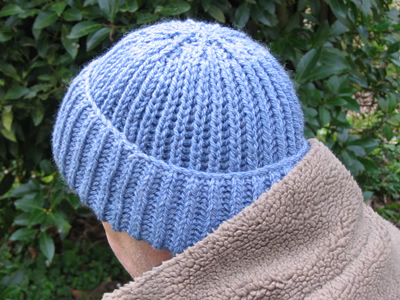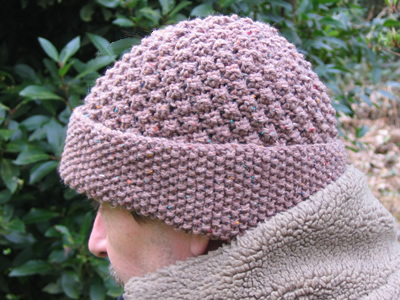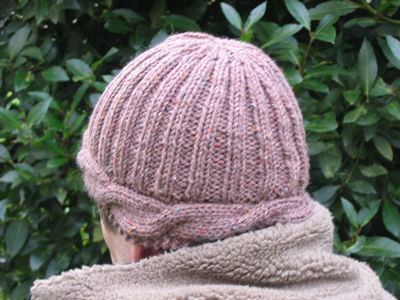Instructions
With No. 5 (5½mm) needles cast on 11 stitches, and work in cable
pattern as follows:
[Editor's note: I
cast on with waste wool, so I could remove it later and graft the ends
of the band together.]
1st row: (wrong side) K3, p6, k2.
2nd row: P2, k6, p1, k2.
Repeat 1st and second rows twice more, then the 1st row again.
8th row: (right side facing) P2, cable
6 (slip the first 3 sts onto a cable needle and leave at the front of
the work; k3, then k3 from cable needle); p1, k2.
9th - 14th rows: Repeat 1st and second
rows 3 times.
Repeat 1st - 14th rows 8 times more (9 patterns in all) ending with row
13. Graft the sts to the cast-on edge to form a circular band, [or cast
off the 11 sts and sew the cast-on to the cast-off edge].
[Editor's note: If
you want to alter the size (circumference) of your hat, now is the time
to do it. Lengthen or shorten this band to the circumference you want
to achieve. See "altering the size"
below.]
One edge of the band has a neat "finished" garter st edging
and the other has a reverse stocking stitch edge, which you will use to
continue knitting the hat in the round.
Change to number 6 (5mm) circular needle and, with right side of work
facing, pick up 92 sts evenly around the reverse stocking stitch edge.
Work in rounds of k2, p2 rib for 5 inches (about 28) rows.
Shape Crown as follows:
1st round: *K2tog,
p2. Repeat from * to end of round.
2nd round: *K1,
p2. Repeat from * to end of round.
Repeat rounds 2 five times more.
8th round: *K1,
p2tog. Repeat from * to end of round.
9th round: *slip1,
k2tog, pass the slipped st over; p1. Repeat from *
to end of round.
Break yarn, thread through remaining sts; draw up and fasten off securely.
Making up:
Sew in all ends.
Changing the hat size, or substituting the wool.
You may want to alter the size (circumference) of your hat, or compensate
for a different gauge.
This pattern relies on making an even number of cables around the hat,
so to lengthen or shorten the band, you can either add in whole or partial
pattern repeats, or, if you feel up to it, you could alter the number
of rows in the pattern repeat of the cable.
Test your gauge before you start and work out how many rows you need
to make your chosen head circumference size. Start by dividing the number
of rows you calculate by 14, and then try some other numbers, eg 12, 16,
13, or 15, until you are close to getting an exact number of patterns.
[Note that if you choose to work to an uneven number of rows in the repeat,
then you will end up doing your cable operations on purl rows, which is
quite feasible, but approach with caution if your are a beginner in this
field!]
If the above all sounds hopeless to you, then just knit until the band
is the length you require, and just sew the ends of the band together
rather than trying to graft it. You could even work the hat on two needles
instead of in the round, by picking up the stitches from the band before
you sew it up, - and then, when you have finished, you sew a side seam
into the hat, including the band.
Finally if you are altering the size, or compensating for a different
gauge, you will probably need to pick up a different number of stitches
from the band. I usually pick up a number of stitches equal to three quarters
of the number of rows I have knitted.
Example: I
knitted 9 pattern repeats of 14 rows which equals 126 rows in total. Then
126*3/4 = 94.5.
For this hat, you need the number of stitches picked up to be divisible
by 4, and I chose to pick up 92sts. I could equally have chosen 96.
|




